sensor FORD BRONCO 2023 Owners Manual
[x] Cancel search | Manufacturer: FORD, Model Year: 2023, Model line: BRONCO, Model: FORD BRONCO 2023Pages: 642, PDF Size: 14.71 MB
Page 6 of 642
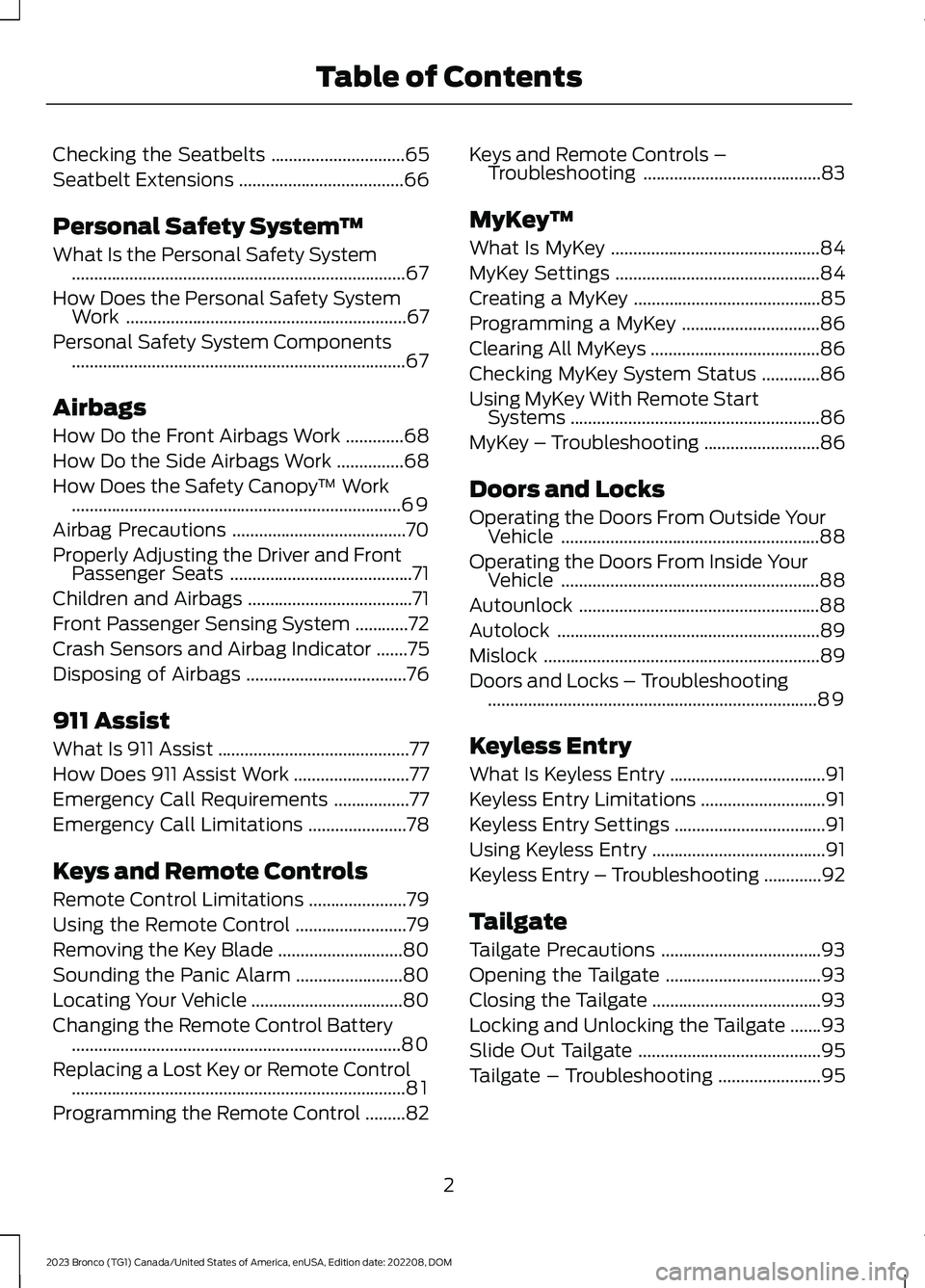
Checking the Seatbelts..............................65
Seatbelt Extensions.....................................66
Personal Safety System™
What Is the Personal Safety System...........................................................................67
How Does the Personal Safety SystemWork...............................................................67
Personal Safety System Components...........................................................................67
Airbags
How Do the Front Airbags Work.............68
How Do the Side Airbags Work...............68
How Does the Safety Canopy™ Work..........................................................................69
Airbag Precautions.......................................70
Properly Adjusting the Driver and FrontPassenger Seats.........................................71
Children and Airbags.....................................71
Front Passenger Sensing System............72
Crash Sensors and Airbag Indicator.......75
Disposing of Airbags....................................76
911 Assist
What Is 911 Assist...........................................77
How Does 911 Assist Work..........................77
Emergency Call Requirements.................77
Emergency Call Limitations......................78
Keys and Remote Controls
Remote Control Limitations......................79
Using the Remote Control.........................79
Removing the Key Blade............................80
Sounding the Panic Alarm........................80
Locating Your Vehicle..................................80
Changing the Remote Control Battery..........................................................................80
Replacing a Lost Key or Remote Control...........................................................................81
Programming the Remote Control.........82
Keys and Remote Controls –Troubleshooting........................................83
MyKey™
What Is MyKey...............................................84
MyKey Settings..............................................84
Creating a MyKey..........................................85
Programming a MyKey...............................86
Clearing All MyKeys......................................86
Checking MyKey System Status.............86
Using MyKey With Remote StartSystems........................................................86
MyKey – Troubleshooting..........................86
Doors and Locks
Operating the Doors From Outside YourVehicle..........................................................88
Operating the Doors From Inside YourVehicle..........................................................88
Autounlock......................................................88
Autolock...........................................................89
Mislock..............................................................89
Doors and Locks – Troubleshooting..........................................................................89
Keyless Entry
What Is Keyless Entry...................................91
Keyless Entry Limitations............................91
Keyless Entry Settings..................................91
Using Keyless Entry.......................................91
Keyless Entry – Troubleshooting.............92
Tailgate
Tailgate Precautions....................................93
Opening the Tailgate...................................93
Closing the Tailgate......................................93
Locking and Unlocking the Tailgate.......93
Slide Out Tailgate.........................................95
Tailgate – Troubleshooting.......................95
2
2023 Bronco (TG1) Canada/United States of America, enUSA, Edition date: 202208, DOMTable of Contents
Page 13 of 642
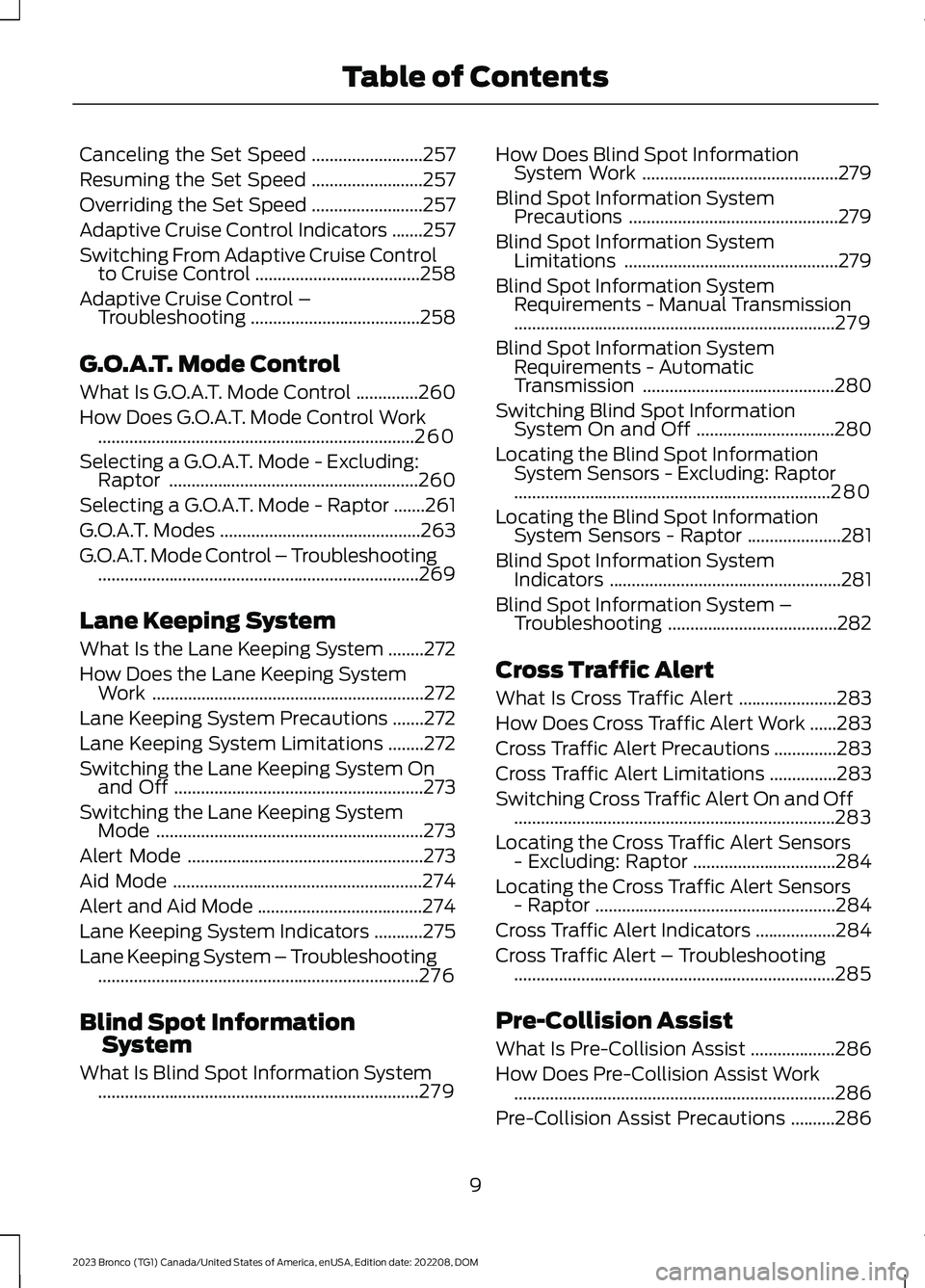
Canceling the Set Speed.........................257
Resuming the Set Speed.........................257
Overriding the Set Speed.........................257
Adaptive Cruise Control Indicators.......257
Switching From Adaptive Cruise Controlto Cruise Control.....................................258
Adaptive Cruise Control –Troubleshooting......................................258
G.O.A.T. Mode Control
What Is G.O.A.T. Mode Control..............260
How Does G.O.A.T. Mode Control Work.......................................................................260
Selecting a G.O.A.T. Mode - Excluding:Raptor........................................................260
Selecting a G.O.A.T. Mode - Raptor.......261
G.O.A.T. Modes.............................................263
G.O.A.T. Mode Control – Troubleshooting........................................................................269
Lane Keeping System
What Is the Lane Keeping System........272
How Does the Lane Keeping SystemWork.............................................................272
Lane Keeping System Precautions.......272
Lane Keeping System Limitations........272
Switching the Lane Keeping System Onand Off........................................................273
Switching the Lane Keeping SystemMode............................................................273
Alert Mode.....................................................273
Aid Mode........................................................274
Alert and Aid Mode.....................................274
Lane Keeping System Indicators...........275
Lane Keeping System – Troubleshooting........................................................................276
Blind Spot InformationSystem
What Is Blind Spot Information System........................................................................279
How Does Blind Spot InformationSystem Work............................................279
Blind Spot Information SystemPrecautions...............................................279
Blind Spot Information SystemLimitations................................................279
Blind Spot Information SystemRequirements - Manual Transmission........................................................................279
Blind Spot Information SystemRequirements - AutomaticTransmission...........................................280
Switching Blind Spot InformationSystem On and Off...............................280
Locating the Blind Spot InformationSystem Sensors - Excluding: Raptor.......................................................................280
Locating the Blind Spot InformationSystem Sensors - Raptor.....................281
Blind Spot Information SystemIndicators....................................................281
Blind Spot Information System –Troubleshooting......................................282
Cross Traffic Alert
What Is Cross Traffic Alert......................283
How Does Cross Traffic Alert Work......283
Cross Traffic Alert Precautions..............283
Cross Traffic Alert Limitations...............283
Switching Cross Traffic Alert On and Off........................................................................283
Locating the Cross Traffic Alert Sensors- Excluding: Raptor................................284
Locating the Cross Traffic Alert Sensors- Raptor......................................................284
Cross Traffic Alert Indicators..................284
Cross Traffic Alert – Troubleshooting........................................................................285
Pre-Collision Assist
What Is Pre-Collision Assist...................286
How Does Pre-Collision Assist Work........................................................................286
Pre-Collision Assist Precautions..........286
9
2023 Bronco (TG1) Canada/United States of America, enUSA, Edition date: 202208, DOMTable of Contents
Page 14 of 642
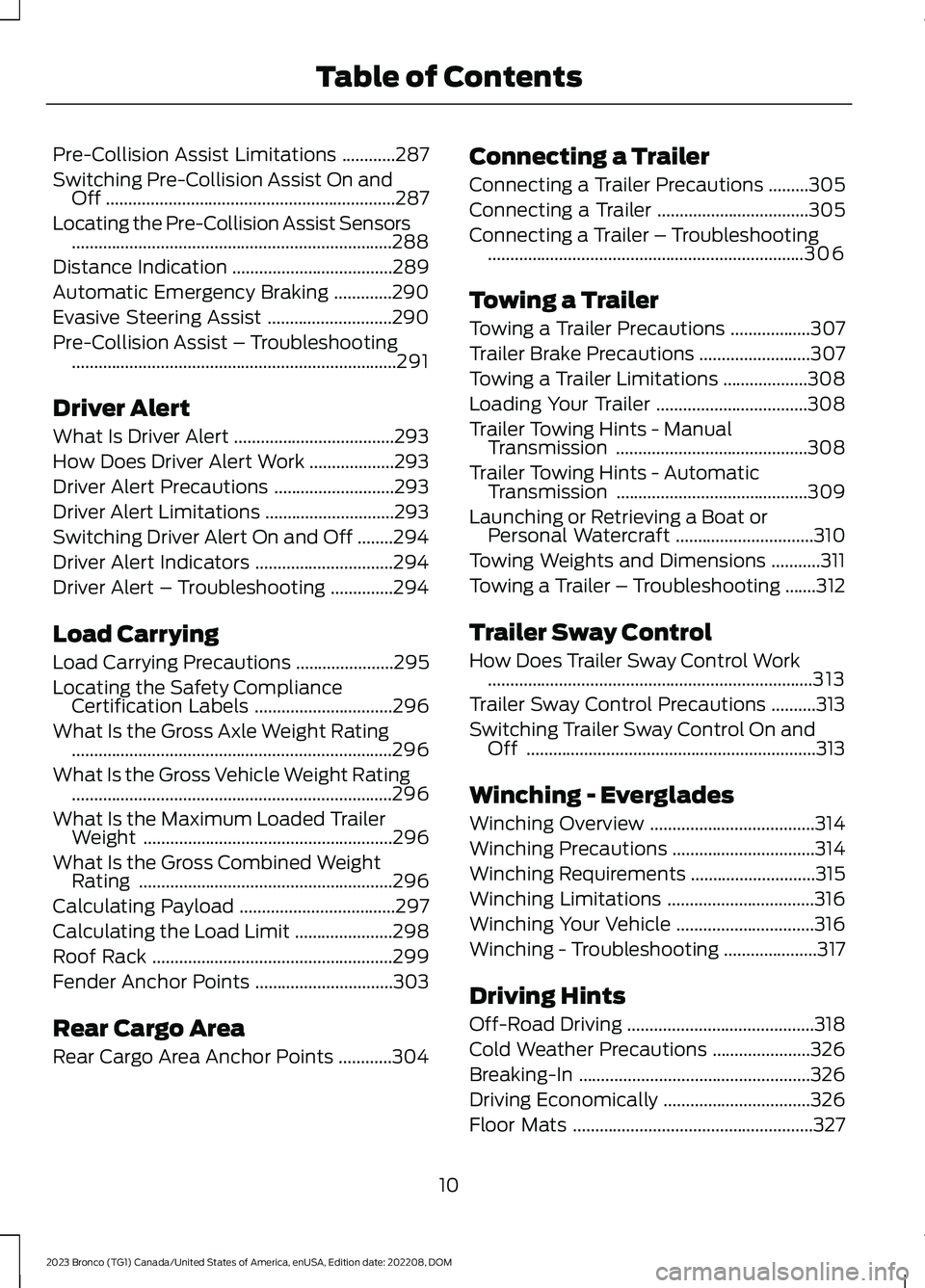
Pre-Collision Assist Limitations............287
Switching Pre-Collision Assist On andOff.................................................................287
Locating the Pre-Collision Assist Sensors........................................................................288
Distance Indication....................................289
Automatic Emergency Braking.............290
Evasive Steering Assist............................290
Pre-Collision Assist – Troubleshooting.........................................................................291
Driver Alert
What Is Driver Alert....................................293
How Does Driver Alert Work...................293
Driver Alert Precautions...........................293
Driver Alert Limitations.............................293
Switching Driver Alert On and Off........294
Driver Alert Indicators...............................294
Driver Alert – Troubleshooting..............294
Load Carrying
Load Carrying Precautions......................295
Locating the Safety ComplianceCertification Labels...............................296
What Is the Gross Axle Weight Rating........................................................................296
What Is the Gross Vehicle Weight Rating........................................................................296
What Is the Maximum Loaded TrailerWeight........................................................296
What Is the Gross Combined WeightRating.........................................................296
Calculating Payload...................................297
Calculating the Load Limit......................298
Roof Rack......................................................299
Fender Anchor Points...............................303
Rear Cargo Area
Rear Cargo Area Anchor Points............304
Connecting a Trailer
Connecting a Trailer Precautions.........305
Connecting a Trailer..................................305
Connecting a Trailer – Troubleshooting.......................................................................306
Towing a Trailer
Towing a Trailer Precautions..................307
Trailer Brake Precautions.........................307
Towing a Trailer Limitations...................308
Loading Your Trailer..................................308
Trailer Towing Hints - ManualTransmission...........................................308
Trailer Towing Hints - AutomaticTransmission...........................................309
Launching or Retrieving a Boat orPersonal Watercraft...............................310
Towing Weights and Dimensions...........311
Towing a Trailer – Troubleshooting.......312
Trailer Sway Control
How Does Trailer Sway Control Work.........................................................................313
Trailer Sway Control Precautions..........313
Switching Trailer Sway Control On andOff.................................................................313
Winching - Everglades
Winching Overview.....................................314
Winching Precautions................................314
Winching Requirements............................315
Winching Limitations.................................316
Winching Your Vehicle...............................316
Winching - Troubleshooting.....................317
Driving Hints
Off-Road Driving..........................................318
Cold Weather Precautions......................326
Breaking-In....................................................326
Driving Economically.................................326
Floor Mats......................................................327
10
2023 Bronco (TG1) Canada/United States of America, enUSA, Edition date: 202208, DOMTable of Contents
Page 66 of 642
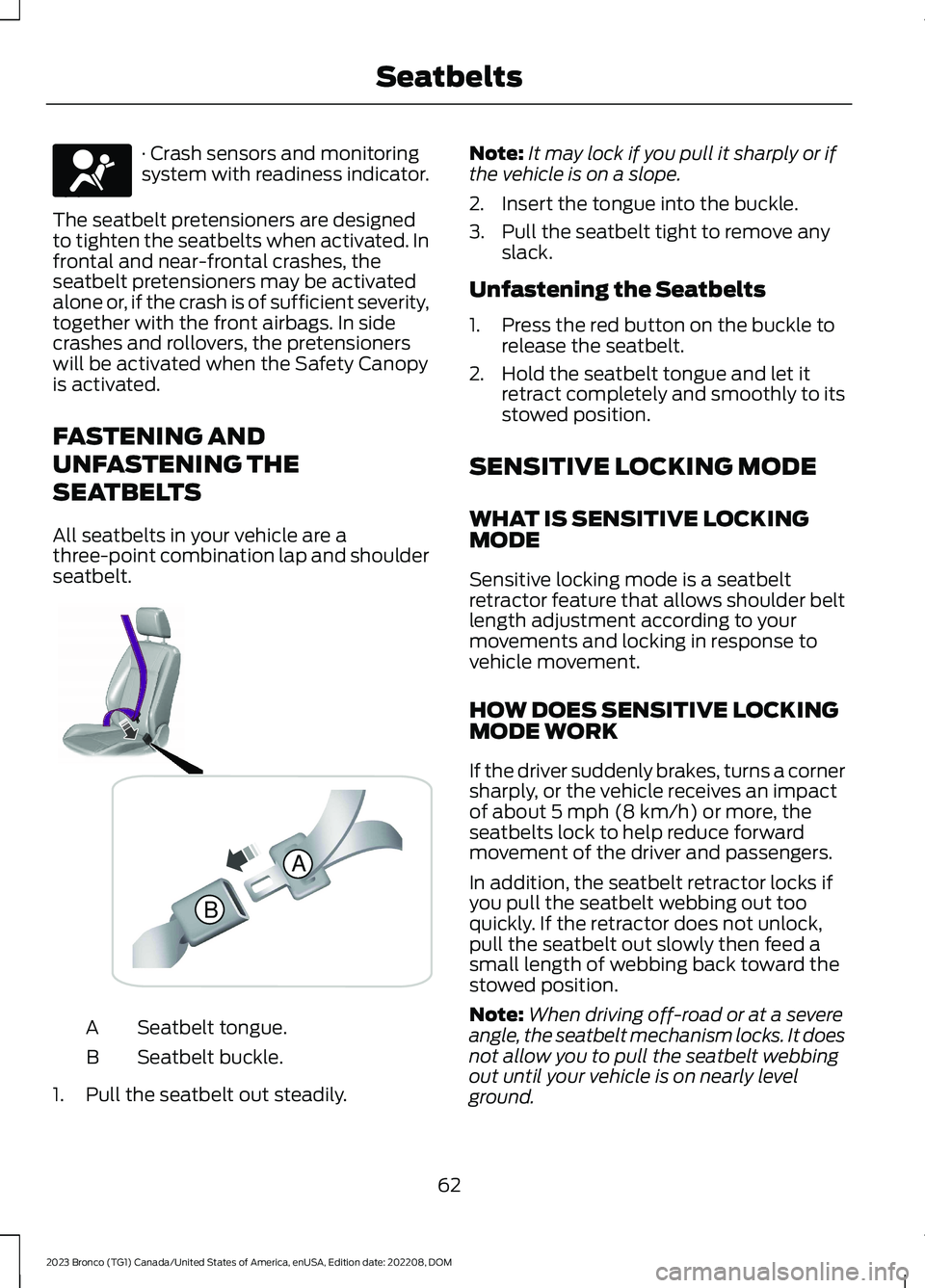
· Crash sensors and monitoringsystem with readiness indicator.
The seatbelt pretensioners are designedto tighten the seatbelts when activated. Infrontal and near-frontal crashes, theseatbelt pretensioners may be activatedalone or, if the crash is of sufficient severity,together with the front airbags. In sidecrashes and rollovers, the pretensionerswill be activated when the Safety Canopyis activated.
FASTENING AND
UNFASTENING THE
SEATBELTS
All seatbelts in your vehicle are athree-point combination lap and shoulderseatbelt.
Seatbelt tongue.A
Seatbelt buckle.B
1.Pull the seatbelt out steadily.
Note:It may lock if you pull it sharply or ifthe vehicle is on a slope.
2.Insert the tongue into the buckle.
3.Pull the seatbelt tight to remove anyslack.
Unfastening the Seatbelts
1.Press the red button on the buckle torelease the seatbelt.
2.Hold the seatbelt tongue and let itretract completely and smoothly to itsstowed position.
SENSITIVE LOCKING MODE
WHAT IS SENSITIVE LOCKINGMODE
Sensitive locking mode is a seatbeltretractor feature that allows shoulder beltlength adjustment according to yourmovements and locking in response tovehicle movement.
HOW DOES SENSITIVE LOCKINGMODE WORK
If the driver suddenly brakes, turns a cornersharply, or the vehicle receives an impactof about 5 mph (8 km/h) or more, theseatbelts lock to help reduce forwardmovement of the driver and passengers.
In addition, the seatbelt retractor locks ifyou pull the seatbelt webbing out tooquickly. If the retractor does not unlock,pull the seatbelt out slowly then feed asmall length of webbing back toward thestowed position.
Note:When driving off-road or at a severeangle, the seatbelt mechanism locks. It doesnot allow you to pull the seatbelt webbingout until your vehicle is on nearly levelground.
62
2023 Bronco (TG1) Canada/United States of America, enUSA, Edition date: 202208, DOMSeatbeltsE67017 BA E338014
Page 71 of 642
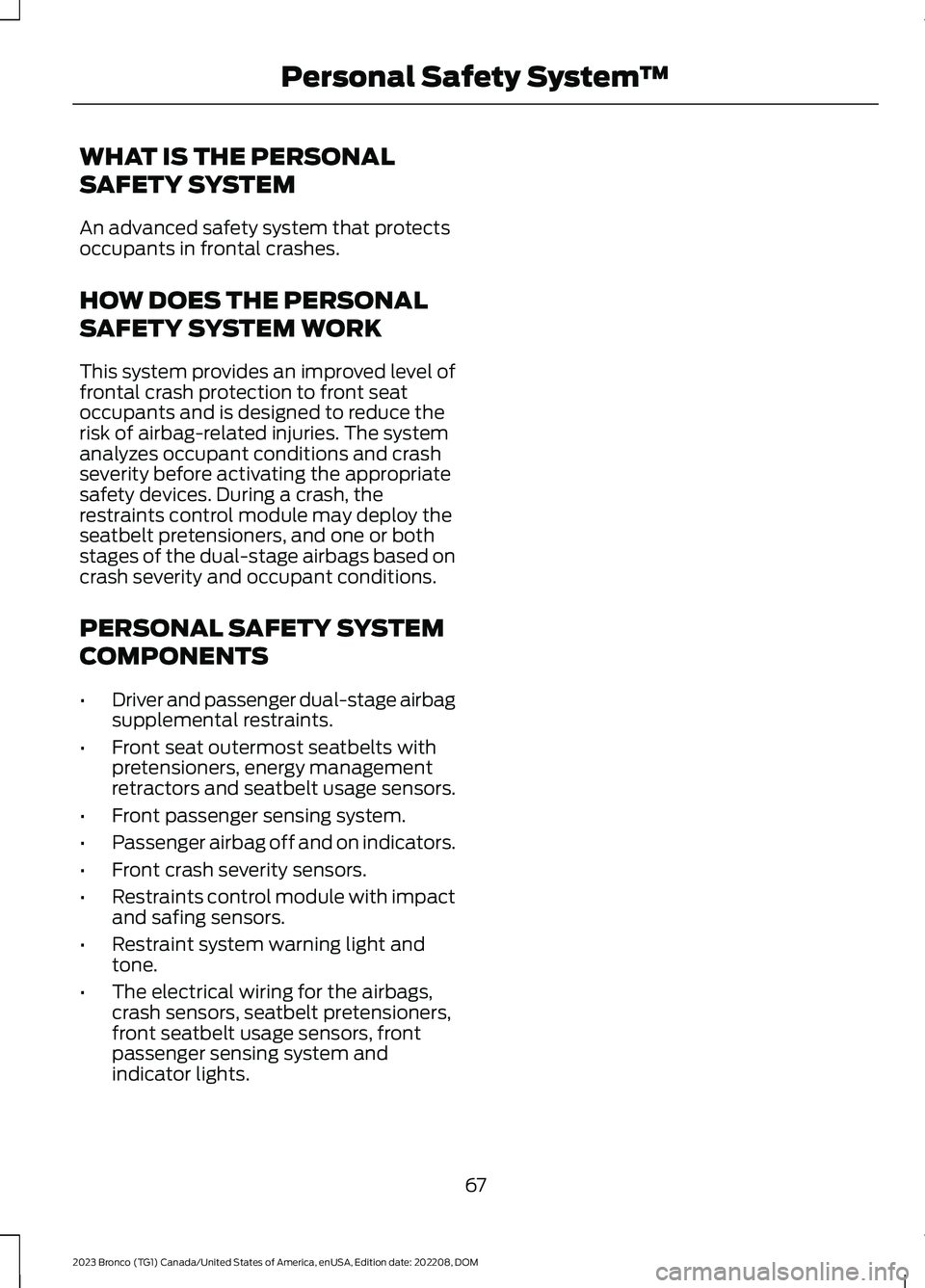
WHAT IS THE PERSONAL
SAFETY SYSTEM
An advanced safety system that protectsoccupants in frontal crashes.
HOW DOES THE PERSONAL
SAFETY SYSTEM WORK
This system provides an improved level offrontal crash protection to front seatoccupants and is designed to reduce therisk of airbag-related injuries. The systemanalyzes occupant conditions and crashseverity before activating the appropriatesafety devices. During a crash, therestraints control module may deploy theseatbelt pretensioners, and one or bothstages of the dual-stage airbags based oncrash severity and occupant conditions.
PERSONAL SAFETY SYSTEM
COMPONENTS
•Driver and passenger dual-stage airbagsupplemental restraints.
•Front seat outermost seatbelts withpretensioners, energy managementretractors and seatbelt usage sensors.
•Front passenger sensing system.
•Passenger airbag off and on indicators.
•Front crash severity sensors.
•Restraints control module with impactand safing sensors.
•Restraint system warning light andtone.
•The electrical wiring for the airbags,crash sensors, seatbelt pretensioners,front seatbelt usage sensors, frontpassenger sensing system andindicator lights.
67
2023 Bronco (TG1) Canada/United States of America, enUSA, Edition date: 202208, DOMPersonal Safety System™
Page 72 of 642
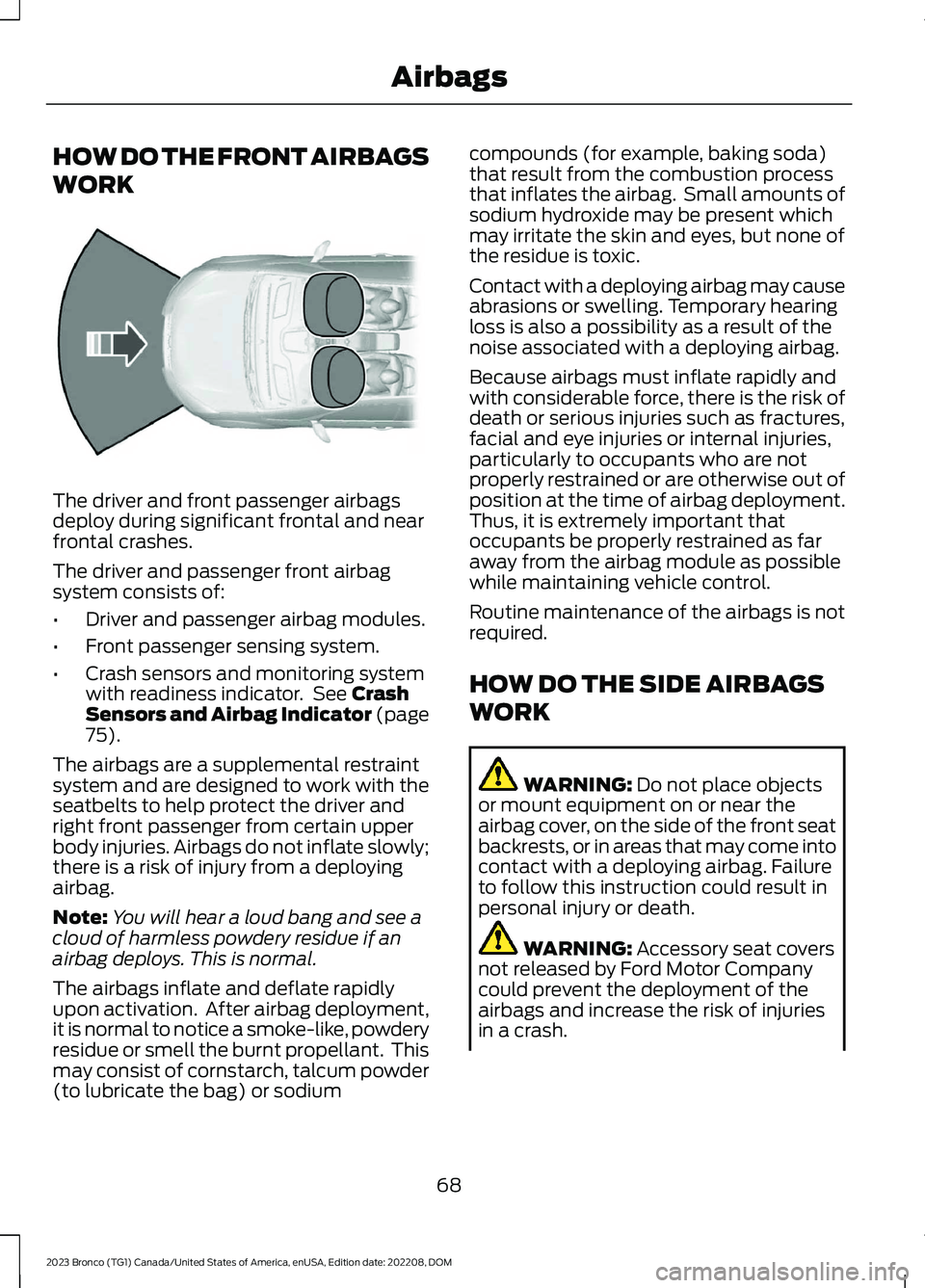
HOW DO THE FRONT AIRBAGS
WORK
The driver and front passenger airbagsdeploy during significant frontal and nearfrontal crashes.
The driver and passenger front airbagsystem consists of:
•Driver and passenger airbag modules.
•Front passenger sensing system.
•Crash sensors and monitoring systemwith readiness indicator. See CrashSensors and Airbag Indicator (page75).
The airbags are a supplemental restraintsystem and are designed to work with theseatbelts to help protect the driver andright front passenger from certain upperbody injuries. Airbags do not inflate slowly;there is a risk of injury from a deployingairbag.
Note:You will hear a loud bang and see acloud of harmless powdery residue if anairbag deploys. This is normal.
The airbags inflate and deflate rapidlyupon activation. After airbag deployment,it is normal to notice a smoke-like, powderyresidue or smell the burnt propellant. Thismay consist of cornstarch, talcum powder(to lubricate the bag) or sodium
compounds (for example, baking soda)that result from the combustion processthat inflates the airbag. Small amounts ofsodium hydroxide may be present whichmay irritate the skin and eyes, but none ofthe residue is toxic.
Contact with a deploying airbag may causeabrasions or swelling. Temporary hearingloss is also a possibility as a result of thenoise associated with a deploying airbag.
Because airbags must inflate rapidly andwith considerable force, there is the risk ofdeath or serious injuries such as fractures,facial and eye injuries or internal injuries,particularly to occupants who are notproperly restrained or are otherwise out ofposition at the time of airbag deployment.Thus, it is extremely important thatoccupants be properly restrained as faraway from the airbag module as possiblewhile maintaining vehicle control.
Routine maintenance of the airbags is notrequired.
HOW DO THE SIDE AIRBAGS
WORK
WARNING: Do not place objectsor mount equipment on or near theairbag cover, on the side of the front seatbackrests, or in areas that may come intocontact with a deploying airbag. Failureto follow this instruction could result inpersonal injury or death.
WARNING: Accessory seat coversnot released by Ford Motor Companycould prevent the deployment of theairbags and increase the risk of injuriesin a crash.
68
2023 Bronco (TG1) Canada/United States of America, enUSA, Edition date: 202208, DOMAirbagsE151127
Page 73 of 642
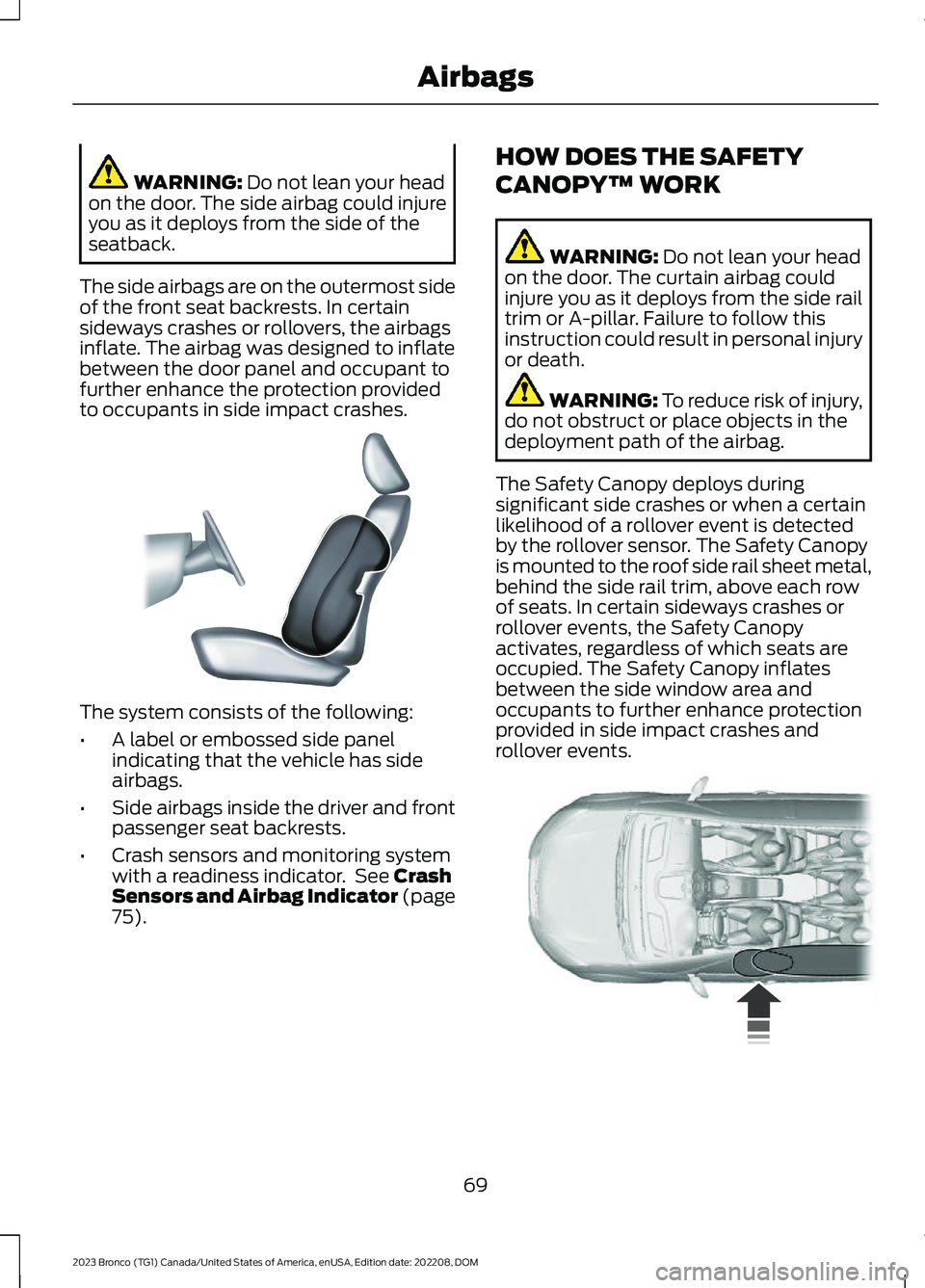
WARNING: Do not lean your headon the door. The side airbag could injureyou as it deploys from the side of theseatback.
The side airbags are on the outermost sideof the front seat backrests. In certainsideways crashes or rollovers, the airbagsinflate. The airbag was designed to inflatebetween the door panel and occupant tofurther enhance the protection providedto occupants in side impact crashes.
The system consists of the following:
•A label or embossed side panelindicating that the vehicle has sideairbags.
•Side airbags inside the driver and frontpassenger seat backrests.
•Crash sensors and monitoring systemwith a readiness indicator. See CrashSensors and Airbag Indicator (page75).
HOW DOES THE SAFETY
CANOPY™ WORK
WARNING: Do not lean your headon the door. The curtain airbag couldinjure you as it deploys from the side railtrim or A-pillar. Failure to follow thisinstruction could result in personal injuryor death.
WARNING: To reduce risk of injury,do not obstruct or place objects in thedeployment path of the airbag.
The Safety Canopy deploys duringsignificant side crashes or when a certainlikelihood of a rollover event is detectedby the rollover sensor. The Safety Canopyis mounted to the roof side rail sheet metal,behind the side rail trim, above each rowof seats. In certain sideways crashes orrollover events, the Safety Canopyactivates, regardless of which seats areoccupied. The Safety Canopy inflatesbetween the side window area andoccupants to further enhance protectionprovided in side impact crashes androllover events.
69
2023 Bronco (TG1) Canada/United States of America, enUSA, Edition date: 202208, DOMAirbagsE152533 E75004
Page 74 of 642
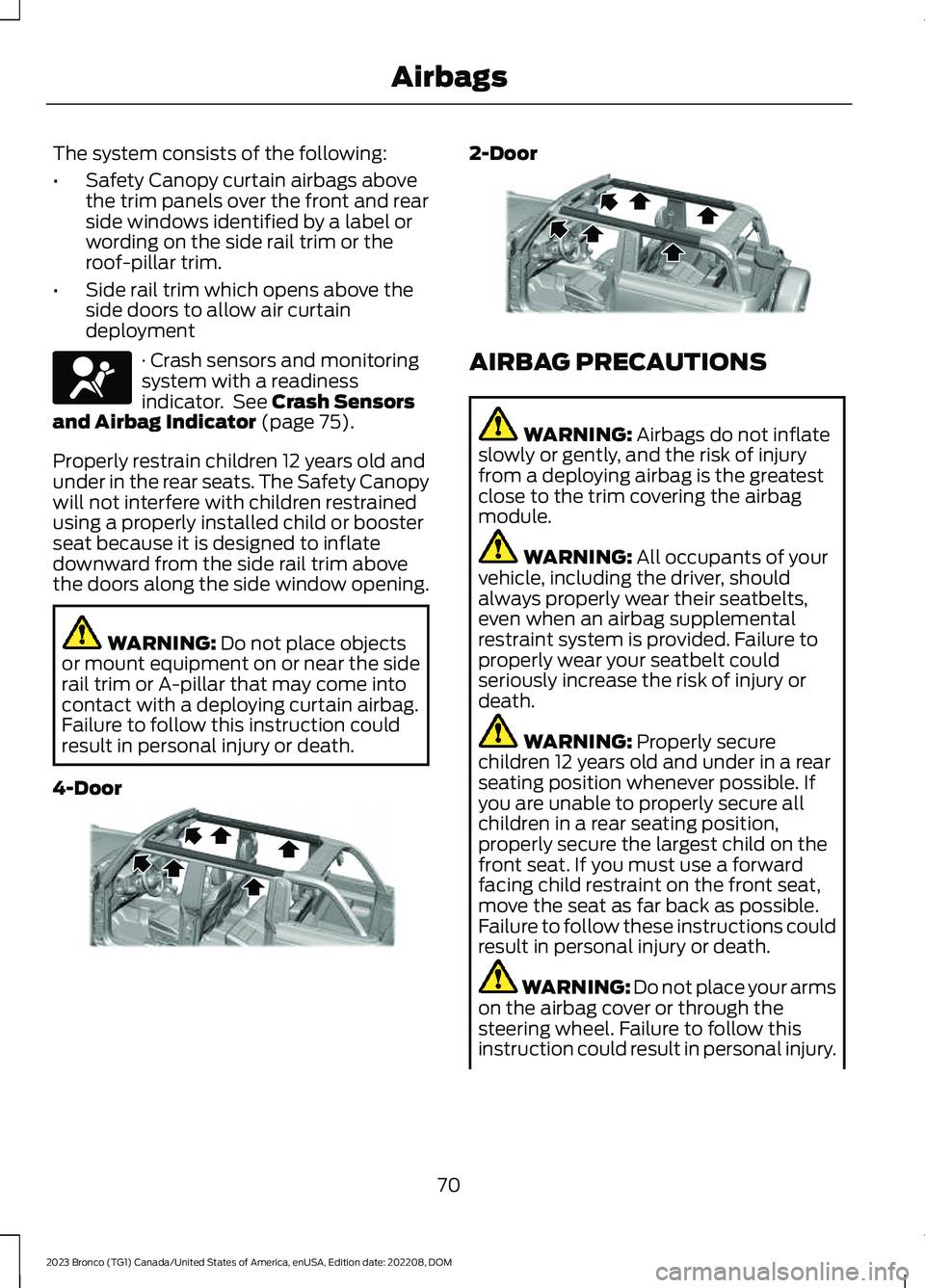
The system consists of the following:
•Safety Canopy curtain airbags abovethe trim panels over the front and rearside windows identified by a label orwording on the side rail trim or theroof-pillar trim.
•Side rail trim which opens above theside doors to allow air curtaindeployment
· Crash sensors and monitoringsystem with a readinessindicator. See Crash Sensorsand Airbag Indicator (page 75).
Properly restrain children 12 years old andunder in the rear seats. The Safety Canopywill not interfere with children restrainedusing a properly installed child or boosterseat because it is designed to inflatedownward from the side rail trim abovethe doors along the side window opening.
WARNING: Do not place objectsor mount equipment on or near the siderail trim or A-pillar that may come intocontact with a deploying curtain airbag.Failure to follow this instruction couldresult in personal injury or death.
4-Door
2-Door
AIRBAG PRECAUTIONS
WARNING: Airbags do not inflateslowly or gently, and the risk of injuryfrom a deploying airbag is the greatestclose to the trim covering the airbagmodule.
WARNING: All occupants of yourvehicle, including the driver, shouldalways properly wear their seatbelts,even when an airbag supplementalrestraint system is provided. Failure toproperly wear your seatbelt couldseriously increase the risk of injury ordeath.
WARNING: Properly securechildren 12 years old and under in a rearseating position whenever possible. Ifyou are unable to properly secure allchildren in a rear seating position,properly secure the largest child on thefront seat. If you must use a forwardfacing child restraint on the front seat,move the seat as far back as possible.Failure to follow these instructions couldresult in personal injury or death.
WARNING: Do not place your armson the airbag cover or through thesteering wheel. Failure to follow thisinstruction could result in personal injury.
70
2023 Bronco (TG1) Canada/United States of America, enUSA, Edition date: 202208, DOMAirbagsE67017 E339113 E339112
Page 76 of 642
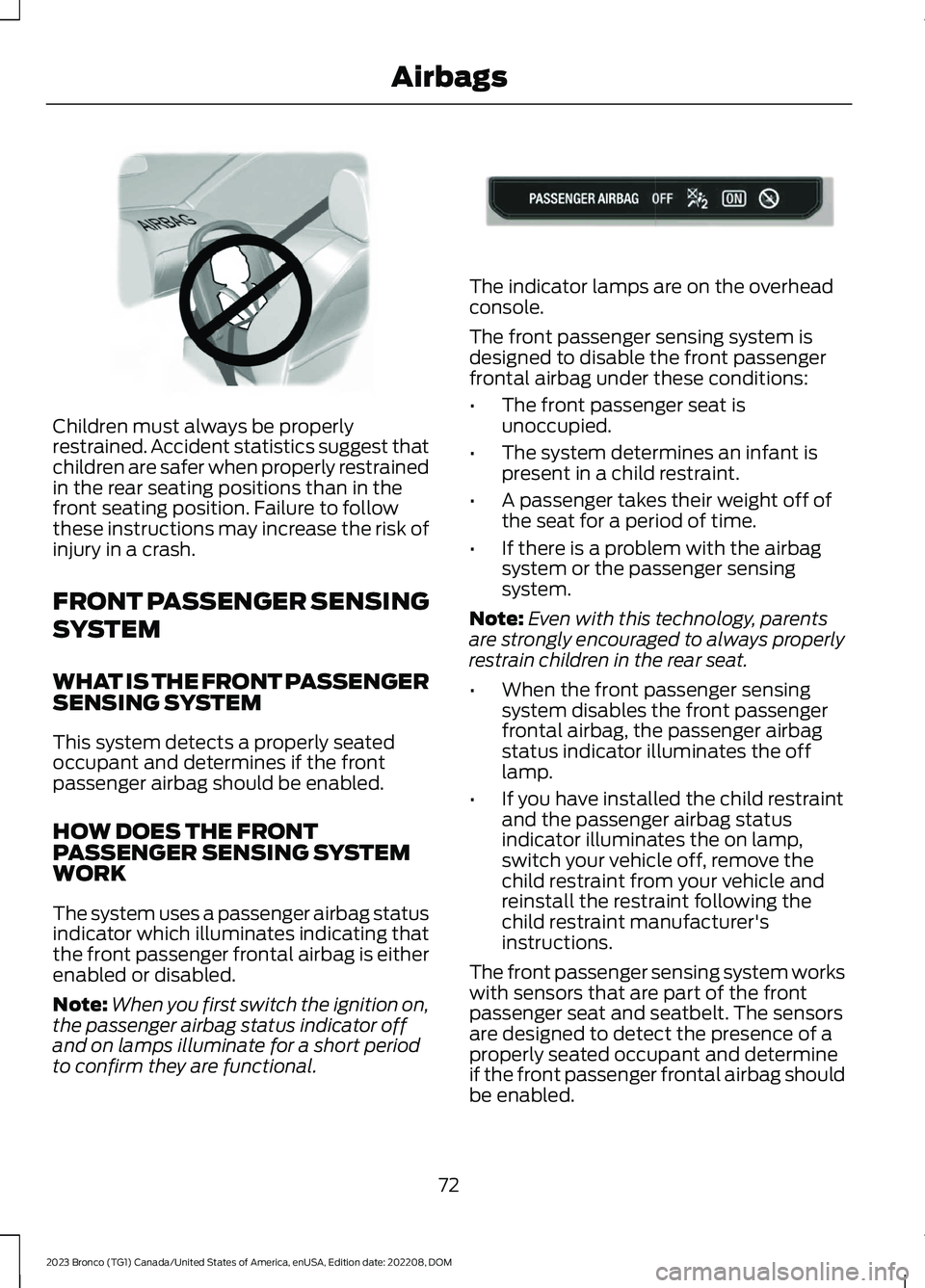
Children must always be properlyrestrained. Accident statistics suggest thatchildren are safer when properly restrainedin the rear seating positions than in thefront seating position. Failure to followthese instructions may increase the risk ofinjury in a crash.
FRONT PASSENGER SENSING
SYSTEM
WHAT IS THE FRONT PASSENGERSENSING SYSTEM
This system detects a properly seatedoccupant and determines if the frontpassenger airbag should be enabled.
HOW DOES THE FRONTPASSENGER SENSING SYSTEMWORK
The system uses a passenger airbag statusindicator which illuminates indicating thatthe front passenger frontal airbag is eitherenabled or disabled.
Note:When you first switch the ignition on,the passenger airbag status indicator offand on lamps illuminate for a short periodto confirm they are functional.
The indicator lamps are on the overheadconsole.
The front passenger sensing system isdesigned to disable the front passengerfrontal airbag under these conditions:
•The front passenger seat isunoccupied.
•The system determines an infant ispresent in a child restraint.
•A passenger takes their weight off ofthe seat for a period of time.
•If there is a problem with the airbagsystem or the passenger sensingsystem.
Note:Even with this technology, parentsare strongly encouraged to always properlyrestrain children in the rear seat.
•When the front passenger sensingsystem disables the front passengerfrontal airbag, the passenger airbagstatus indicator illuminates the offlamp.
•If you have installed the child restraintand the passenger airbag statusindicator illuminates the on lamp,switch your vehicle off, remove thechild restraint from your vehicle andreinstall the restraint following thechild restraint manufacturer'sinstructions.
The front passenger sensing system workswith sensors that are part of the frontpassenger seat and seatbelt. The sensorsare designed to detect the presence of aproperly seated occupant and determineif the front passenger frontal airbag shouldbe enabled.
72
2023 Bronco (TG1) Canada/United States of America, enUSA, Edition date: 202208, DOMAirbagsE142846 E181984
Page 77 of 642
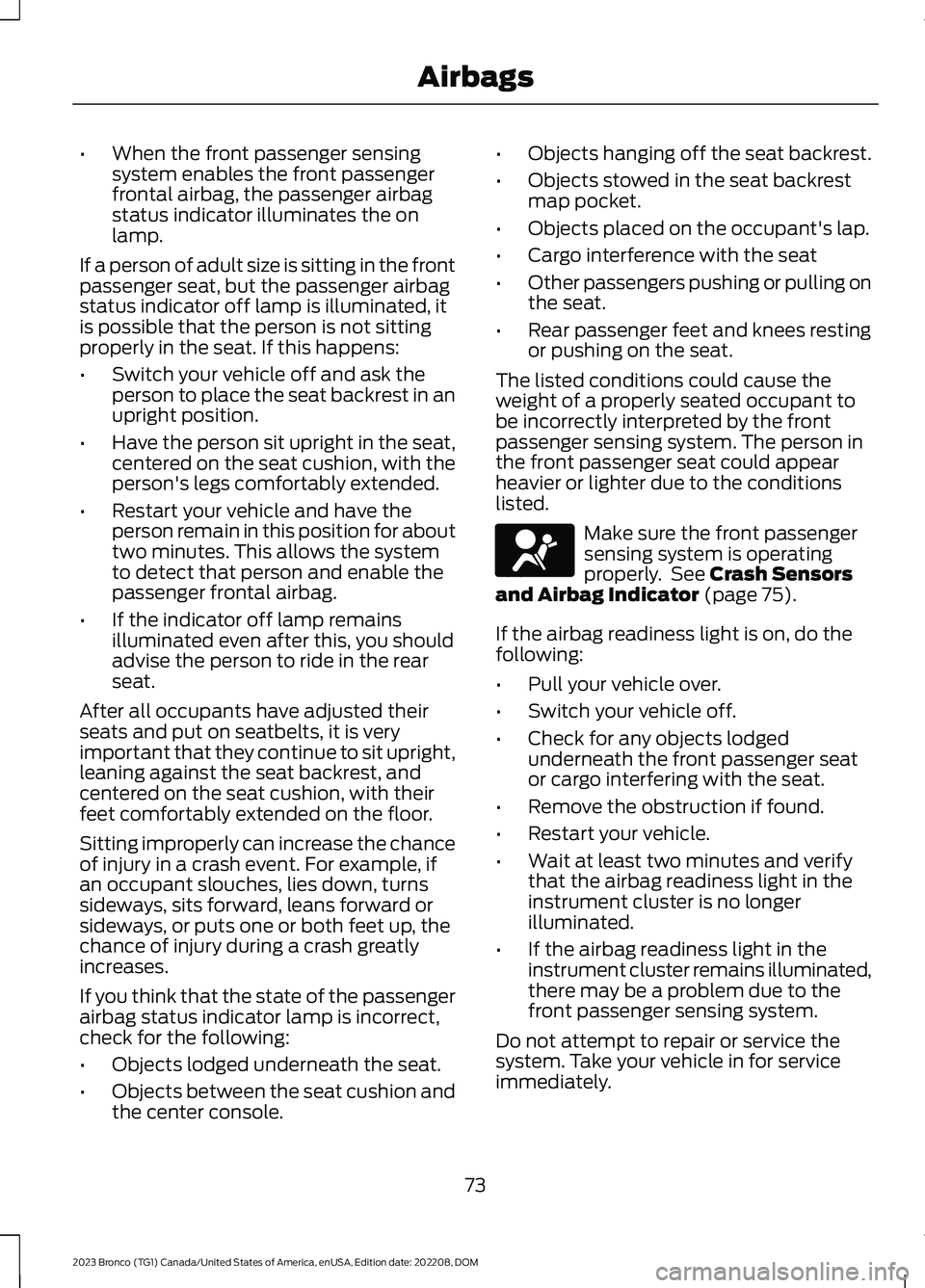
•When the front passenger sensingsystem enables the front passengerfrontal airbag, the passenger airbagstatus indicator illuminates the onlamp.
If a person of adult size is sitting in the frontpassenger seat, but the passenger airbagstatus indicator off lamp is illuminated, itis possible that the person is not sittingproperly in the seat. If this happens:
•Switch your vehicle off and ask theperson to place the seat backrest in anupright position.
•Have the person sit upright in the seat,centered on the seat cushion, with theperson's legs comfortably extended.
•Restart your vehicle and have theperson remain in this position for abouttwo minutes. This allows the systemto detect that person and enable thepassenger frontal airbag.
•If the indicator off lamp remainsilluminated even after this, you shouldadvise the person to ride in the rearseat.
After all occupants have adjusted theirseats and put on seatbelts, it is veryimportant that they continue to sit upright,leaning against the seat backrest, andcentered on the seat cushion, with theirfeet comfortably extended on the floor.
Sitting improperly can increase the chanceof injury in a crash event. For example, ifan occupant slouches, lies down, turnssideways, sits forward, leans forward orsideways, or puts one or both feet up, thechance of injury during a crash greatlyincreases.
If you think that the state of the passengerairbag status indicator lamp is incorrect,check for the following:
•Objects lodged underneath the seat.
•Objects between the seat cushion andthe center console.
•Objects hanging off the seat backrest.
•Objects stowed in the seat backrestmap pocket.
•Objects placed on the occupant's lap.
•Cargo interference with the seat
•Other passengers pushing or pulling onthe seat.
•Rear passenger feet and knees restingor pushing on the seat.
The listed conditions could cause theweight of a properly seated occupant tobe incorrectly interpreted by the frontpassenger sensing system. The person inthe front passenger seat could appearheavier or lighter due to the conditionslisted.
Make sure the front passengersensing system is operatingproperly. See Crash Sensorsand Airbag Indicator (page 75).
If the airbag readiness light is on, do thefollowing:
•Pull your vehicle over.
•Switch your vehicle off.
•Check for any objects lodgedunderneath the front passenger seator cargo interfering with the seat.
•Remove the obstruction if found.
•Restart your vehicle.
•Wait at least two minutes and verifythat the airbag readiness light in theinstrument cluster is no longerilluminated.
•If the airbag readiness light in theinstrument cluster remains illuminated,there may be a problem due to thefront passenger sensing system.
Do not attempt to repair or service thesystem. Take your vehicle in for serviceimmediately.
73
2023 Bronco (TG1) Canada/United States of America, enUSA, Edition date: 202208, DOMAirbagsE67017